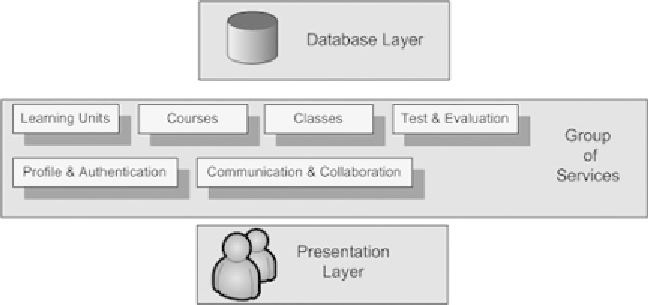Information Technology Reference
In-Depth Information
connection and tests whether the platform is
installed correctly.
The layer responsible for presenting informa-
tion to the user is the presentation layer. The entire
graphical user interface is controlled through this
layer as well as all user-system interactions.
Platform services are made available to users
according to the user level they have. The authen-
tication service is responsible for distinguishing
which user runs what service and sets the level
of functionality of the service. For instance, the
logging service can be used only by administrators
and instructors, but when a learner is authenti-
cated, logging starts only for session recording,
not for viewing.
Platform services are grouped by their func-
tionality and their target group, e.g. live chat,
email and instant messaging are grouped under
Communication & Collaboration Services. Some
of these services are only offered to instructors
whereas others are offered both to instructors and
learners. Figure 2 shows the grouping of services
along with the services each group has.
Diplek Layers
As mentioned before, Diplek is using service
oriented architecture (Erl, 2005; Papazoglou &
van den Heuvel, 2007). This design enables the
transparent addition of extra functions after the
platform is deployed thus offering the users new
tools and services. Figure 1 shows the three layers.
The database layer is responsible for storing
user and course data. These data are stored by
using a logical organization like tables. This
layer is also responsible for offering the necessary
bridge for connecting the stored data with the
system services.
The services layer is the connecting link
between the database and the presentation layer.
Before content is displayed to the user, it is filtered
and rearranged by the different group of services
that intervene. As with any other service oriented
system, services interact with each other. For in-
stance, the “Live Chat” service interacts with the
“Course Management
”
service in order to enable
members of a course to chat either in private or
in a live chat classroom. This service is disabled
in some cases, like when the “Test & Evaluation”
service is active.
EDUCATIONAL MATERIAL AND
LEARNING OBJECTS
There are many definitions of a Learning Object
(LO). Polsani (2003) describes it as “an indepen-
dent and self-standing unit of learning content that
Figure 1. Layer schema

Search WWH ::

Custom Search